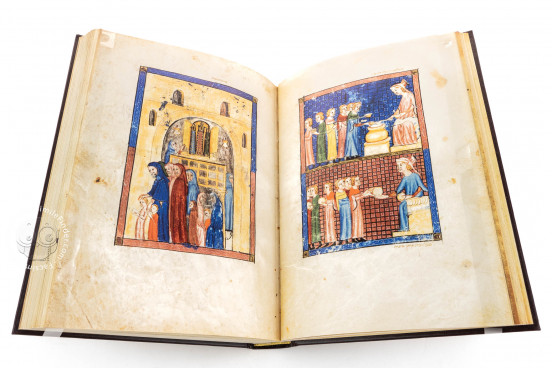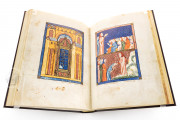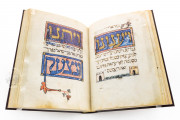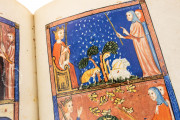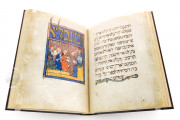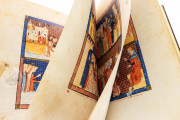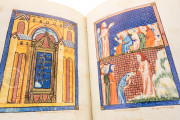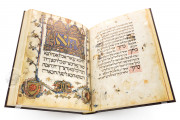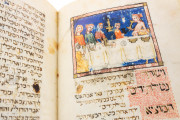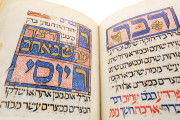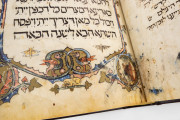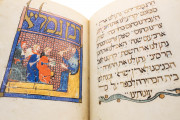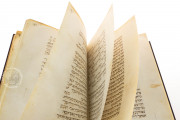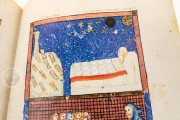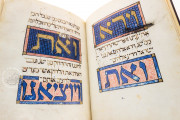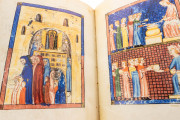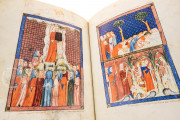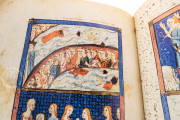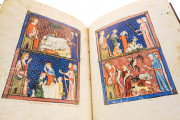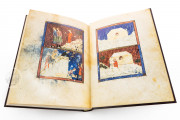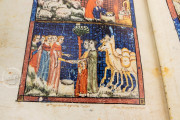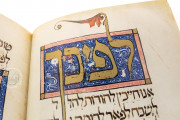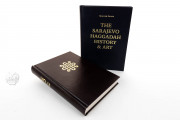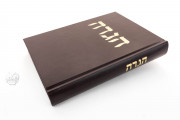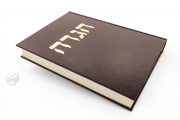The Sarajevo Haggadah is a precious survival of the visual culture of Sephardic Judaism. It is a richly illustrated manuscript guide to the seder, the ritual family meal of the first night—or first and second nights—of the Jewish Passover. Probably made in the Crown of Aragon around 1335, the manuscript opens with a splendid sequence of thirty-four prefatory miniatures in the fashionable Gothic style. The biblical scenes are remarkable for adapting Christian compositional models to fit the Jewish context, often incorporating details that reflect Jewish commentary.
In Europe, the seder is celebrated on the first two nights of the Passover festival, which lasts eight days and commemorates the Exodus of the ancient Israelites from Egypt. Symbolic dishes—bitter herbs and unleavened bread—remind the faithful of the haste with which their forebears fled Egypt.
The Opening Books of the Torah Illustrated
The miniatures of the prefatory picture cycle, all the work of one artist, are painted on the flesh sides only of the parchment so that a blank opening follows each fully painted opening. The biblical cycle begins with a representation of the world "unformed and void" (Genesis 1:1; fol. 1v) and extends to the designation of Joshua as Moses's successor in leading the Israelites (Deuteronomy 34:9; fol. 31v). Inscriptions above and below the miniatures identify the scenes with abridged biblical texts.
Representations of the Temple (fol. 32r), preparations of foods for the seder; fol. 33v), and a contemporary family leaving a synagogue (fol. 34r) complete the prefatory cycle, whose leaves are numbered in sequence on the pages with the miniatures (fols. 1-34).
The Seder Meal as Remembrance
The numbering of the leaves begins anew on the rectos (left-hand pages) for the Haggadah's text, which has painted decoration (here designated fols. 1*-50*) and continues through the undecorated poems for Passover week (fols. 53*-104*). Dozens of painted word panels and two miniatures embellish the Haggadah proper.
One miniature depicts the seder meal, providing insight into medieval Sephardic family life (fol. 31*v). The master of the house is shown at the right, lifting a goblet to his mouth with his right hand and resting his left arm on a cushion, as stipulated in the order of the seder. This reclining pose imitates dining customs in antiquity, underlining the connection between those celebrating the Passover and the world of the Exodus story.
Jewish Artists, Christian Models
The prefatory miniatures reveal their designer's familiarity with the compositions of the same scenes in Christian books produced at the royal court of France in the thirteenth century, including the Saint Louis Psalter. It is debated whether the designers were more probably Christian or Jewish. The current thinking is that they were Jews familiar with rabbinic biblical commentary (midrash), which often informs the images.
Colored Inks and Pen-Flourishing
The manuscript was written by two scribes in Hebrew Square Script, one responsible for the Haggadah proper and the other for the section of poems. Opening words and closing formulas are in red and blue inks, some featuring pen-flourishing in the opposite color.
From Iberia to the Balkans
Coats of arms in the border of fol. 3*r are probably those of the manuscript's first owners, perhaps a couple who received the book upon their marriage. The manuscript was in Italy by 1510, and a papal censor, Giovanni Dominico Vistorini, added a note to indicate that he had reviewed its contents in 1609. One Joseph R. Cohen sold it to the recently established Zemaljski Muzej Bosne i Hercegovine in 1894. It was inscribed on UNESCO's Memory of the World Register in 2017.
We have 1 facsimile edition of the manuscript "Sarajevo Haggadah": Sarajevo Haggadah facsimile edition, published by Sarajevo Svjetlost, 1983
Request Info / Price
